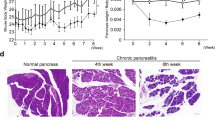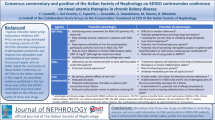Abstract
Chronic kidney disease (CKD) is a global public health issue. CKD is caused by the infiltration of various myeloid cell types into renal tissue, resulting in renal fibrosis and tubular atrophy. Unilateral ureteral obstruction (UUO) surgery in mice is a model of CKD and characterized by high expression of the anti-inflammatory receptor, Triggering receptor expressed on myeloid cells 2 (TREM-2), on myeloid cells in affected kidneys. Here, we show that iNOS expression and nitric oxide (NO) induction were decreased in Trem-2−/− bone marrow-derived DCs (BMDCs) and in Trem-2 knockdown DC2.4 cells stimulated in vitro with LPS. The nitration of RORγt was decreased in T cells co-cultured with LPS-stimulated Trem-2−/− BMDCs, enhancing IL-17 production. UUO-treated Trem-2−/− mice displayed aggravated renal pathogenesis accompanied by greater neutrophil infiltration and enhanced Th17 cells differentiation, phenotypes that could be rescued by the administration of L-arginine (a biological precursor of NO). Our data identify a key mechanism underlying TREM-2-mediated NO to modulate the cellular crosstalk between dendritic cells, Th17, and neutrophils. Furthermore, we also reveal TREM-2 as a potential novel target for the development of anti-inflammatory drugs in CKD treatment.
Key messages
-
The expression of TREM-2 is increased in nephritis
-
TREM-2+ DCs maintain NO production to negatively regulate Th17 differentiation
-
The severe pathologies of nephritis can be rescued by L-arginine supplementation
Graphical Abstract







Similar content being viewed by others
Availability of data and materials
Data and materials related to this study are available upon request.
References
Eknoyan G, Lameire N, Barsoum R et al (2004) The burden of kidney disease: improving global outcomes. Kidney Int 66:1310–1314
Yatim KM, Lakkis FG (2015) A brief journey through the immune system. Clin J Am Soc Nephrol 10:1274–1281
Tecklenborg J, Clayton D, Siebert S et al (2018) The role of the immune system in kidney disease. Clin Exp Immunol 192:142–150
Nagler W (1973) Vertebral artery obstruction by hyperextension of the neck: report of three cases. Arch Phys Med Rehabil 54:237–240
Dong X, Bachman LA, Miller MN et al (2008) Dendritic cells facilitate accumulation of IL-17 T cells in the kidney following acute renal obstruction. Kidney Int 74:1294–1309
Kitamoto K, Machida Y, Uchida J et al (2009) Effects of liposome clodronate on renal leukocyte populations and renal fibrosis in murine obstructive nephropathy. J Pharmacol Sci 111:285–292
Daws MR, Lanier LL, Seaman WE et al (2001) Cloning and characterization of a novel mouse myeloid DAP12-associated receptor family. Eur J Immunol 31:783–791
Turnbull IR, Gilfillan S, Cella M et al (2006) Cutting edge: TREM-2 attenuates macrophage activation. J Immunol 177:3520–3524
Cella M, Buonsanti C, Strader C et al (2003) Impaired differentiation of osteoclasts in TREM-2-deficient individuals. J Exp Med 198:645–651
Takahashi K, Rochford CD, Neumann H (2005) Clearance of apoptotic neurons without inflammation by microglial triggering receptor expressed on myeloid cells-2. J Exp Med 201:647–657
N’Diaye EN, Branda CS, Branda SS et al (2009) TREM-2 (triggering receptor expressed on myeloid cells 2) is a phagocytic receptor for bacteria. J Cell Biol 184:215–223
Hamerman JA, Jarjoura JR, Humphrey MB et al (2006) Cutting edge: inhibition of TLR and FcR responses in macrophages by triggering receptor expressed on myeloid cells (TREM)-2 and DAP12. J Immunol 177:2051–2055
Li C, Zhao B, Lin C et al (2019) TREM2 inhibits inflammatory responses in mouse microglia by suppressing the PI3K/NF-kappaB signaling. Cell Biol Int 43:360–372
Di Virgilio F (2004) New pathways for reactive oxygen species generation in inflammation and potential novel pharmacological targets. Curr Pharm Des 10:1647–1652
Michel T, Feron O (1997) Nitric oxide synthases: which, where, how, and why? J Clin Invest 100:2146–2152
Saini R, Singh S (2019) Inducible nitric oxide synthase: an asset to neutrophils. J Leukoc Biol 105:49–61
Ersoy Y, Ozerol E, Baysal O et al (2002) Serum nitrate and nitrite levels in patients with rheumatoid arthritis, ankylosing spondylitis, and osteoarthritis. Ann Rheum Dis 61:76–78
Oudkerk Pool M, Bouma G, Visser JJ et al (1995) Serum nitrate levels in ulcerative colitis and Crohn′s disease. Scand J Gastroenterol 30:784–788
Nathan CF, Hibbs JB Jr (1991) Role of nitric oxide synthesis in macrophage antimicrobial activity. Curr Opin Immunol 3:65–70
Granger DN, Kubes P (1996) Nitric oxide as antiinflammatory agent. Methods Enzymol 269:434–442
Brune B, von Knethen A, Sandau KB (1999) Nitric oxide (NO): an effector of apoptosis. Cell Death Differ 6:969–975
Li J, Billiar TR (2000) The role of nitric oxide in apoptosis. Semin Perinatol 24:46–50
Niedbala W, Alves-Filho JC, Fukada SY et al (2011) Regulation of type 17 helper T-cell function by nitric oxide during inflammation. Proc Natl Acad Sci U S A 108:9220–9225
Niedbala W, Besnard AG, Jiang HR et al (2013) Nitric oxide-induced regulatory T cells inhibit Th17 but not Th1 cell differentiation and function. J Immunol 191:164–170
Jianjun Y, Zhang R, Lu G et al (2013) T cell-derived inducible nitric oxide synthase switches off Th17 cell differentiation. J Exp Med 210:1447–1462
Shen Z, Reznikoff G, Dranoff G et al (1997) Cloned dendritic cells can present exogenous antigens on both MHC class I and class II molecules. J Immunol 158:2723–2730
Lo TH, Tseng KY, Tsao WS et al (2014) TREM-1 regulates macrophage polarization in ureteral obstruction. Kidney Int 86:1174–1186
Xu K, Wu N, Min Z et al (2020) Adoptive transfer of bone marrow-derived dendritic cells (BMDCs) alleviates OVA-induced allergic airway inflammation in asthmatic mice. Sci Rep 10:13915
Napoli C, Ignarro LJ (2003) Nitric oxide-releasing drugs. Annu Rev Pharmacol Toxicol 43:97–123
Yang FC, Chiu PY, Chen Y et al (2019) TREM-1-dependent M1 macrophage polarization restores intestinal epithelium damaged by DSS-induced colitis by activating IL-22-producing innate lymphoid cells. J Biomed Sci 26:46
Csonka C, Pali T, Bencsik P et al (2015) Measurement of NO in biological samples. Br J Pharmacol 172:1620–1632
Tezuka H, Abe Y, Iwata M et al (2007) Regulation of IgA production by naturally occurring TNF/iNOS-producing dendritic cells. Nature 448:929–933
Tammaro A, Stroo I, Rampanelli E et al (2013) Role of TREM1-DAP12 in renal inflammation during obstructive nephropathy. PLoS ONE 8:e82498
Chung AC, Lan HY (2011) Chemokines in renal injury. J Am Soc Nephrol 22:802–809
Daley JM, Thomay AA, Connolly MD et al (2008) Use of Ly6G-specific monoclonal antibody to deplete neutrophils in mice. J Leukoc Biol 83:64–70
Tapmeier TT, Fearn A, Brown K et al (2010) Pivotal role of CD4+ T cells in renal fibrosis following ureteric obstruction. Kidney Int 78:351–362
Wang H, Wang J, Bai Y et al (2016) CD11c(+) CD8(+) T cells reduce renal fibrosis following ureteric obstruction by inducing fibroblast apoptosis. Int J Mol Sci 18(1):1
Pindjakova J, Hanley SA, Duffy MM et al (2012) Interleukin-1 accounts for intrarenal Th17 cell activation during ureteral obstruction. Kidney Int 81:379–390
Flannigan KL, Ngo VL, Geem D et al (2017) IL-17A-mediated neutrophil recruitment limits expansion of segmented filamentous bacteria. Mucosal Immunol 10:673–684
Miyajima A, Chen J, Poppas DP et al (2001) Role of nitric oxide in renal tubular apoptosis of unilateral ureteral obstruction. Kidney Int 59:1290–1303
Esplugues JV (2002) NO as a signalling molecule in the nervous system. Br J Pharmacol 135:1079–1095
Ito K, Chen J, Vaughan ED Jr et al (2004) Dietary L-arginine supplementation improves the glomerular filtration rate and renal blood flow after 24 hours of unilateral ureteral obstruction in rats. J Urol 171:926–930
Bogdan C, Rollinghoff M, Diefenbach A (2000) The role of nitric oxide in innate immunity. Immunol Rev 173:17–26
Xiong H, Zhu C, Li F et al (2004) Inhibition of interleukin-12 p40 transcription and NF-kappaB activation by nitric oxide in murine macrophages and dendritic cells. J Biol Chem 279:10776–10783
Gupta KJ, Kolbert Z, Durner J et al (2020) Regulating the regulator: nitric oxide control of post-translational modifications. New Phytol 227:1319–1325
Zhai Q, Li F, Chen X et al (2017) Triggering receptor expressed on myeloid cells 2, a novel regulator of immunocyte phenotypes. Confers Neuroprotection by Relieving Neuroinflammation Anesthesiology 127:98–110
Cantoni C, Bollman B, Licastro D et al (2015) TREM2 regulates microglial cell activation in response to demyelination in vivo. Acta Neuropathol 129:429–447
Ito K, Chen J, Seshan SV et al (2005) Dietary arginine supplementation attenuates renal damage after relief of unilateral ureteral obstruction in rats. Kidney Int 68:515–528
Sun D, Wang Y, Liu C et al (2012) Effects of nitric oxide on renal interstitial fibrosis in rats with unilateral ureteral obstruction. Life Sci 90:900–909
Tirani SA, Pezeshki Z, Nematbakhsh M et al (2015) Effect of L-arginine and L-NAME on kidney tissue damage in rats after 24 h of bilateral ureteral obstruction. Int J Prev Med 6:60
Acknowledgements
We thank Dr. W. C. Yeh for his contribution in initiating the Trem-2-/- mouse project during his time at CFIBCR/UHN/Univ. Toronto in Toronto, Canada. We thank Dr. Hui-Chen Chen (China Medical University, Taichung, Taiwan) for providing DC2.4 cells. We thank Dr. Chi-Hung Lin (National Yang Ming Chiao Tung University, Taipei, Taiwan) for providing 293T cells.
Funding
This work was supported by grants to NJC and DCT from the Ministry of Science and Technology of Taiwan (MOST 109–2811-B-010–052, 107–2314-B-075–052, 108–2314-B-075–008, 109–2811-B-010–502) and grants to JLF (MOST 106–2321-B-075–001; 107–2321-B-075–001; 108–2321-B-075–001). PSO and TWM were supported by grants from the Canadian Institute of Health Research, the Leukemia Lymphoma Society, and the Terry Fox Cancer Research Foundation.
Author information
Authors and Affiliations
Contributions
Ching-Cheng Lin performed experiments, analyzed results, and drafted the manuscript. Ti-Yung Chang, Yun-Syuan Wu, Wei Huang, Wei-Chi Lo, Guan-Fu Liu, and Wei-Chan Hsu performed the experiments. Yong-Chen Lu, Pamela S. Ohashi, and Tak W. Mak established and provided the Trem-2−/− mouse model. Jong-Ling Fuh and Nien-Jung Chen identified the role of TREM-2 in iNOS induction in Alzheimer’s disease–related study. Hui-Chen Chen provided the DC2.4 cell line and made suggestions for the manuscript. Der-Cherng Tarng and Nien-Jung Chen designed experiments, analyzed results, interpreted findings, and wrote the final manuscript. All authors read and approved the final manuscript.
Corresponding authors
Ethics declarations
Ethics approval and consent to participate
All animal experiments were performed in accordance with the Institutional Animal Care and Use Committee Guidelines of National Yang Ming Chiao Tung University and carried out following the National Institutes of Health Guidelines for the Care and Use of Laboratory Animals (IACUC number: 1060436).
Consent for publication
Not applicable.
Competing interests
The authors declare no competing interests.
Additional information
Publisher's Note
Springer Nature remains neutral with regard to jurisdictional claims in published maps and institutional affiliations.
Supplementary Information
Below is the link to the electronic supplementary material.
Rights and permissions
About this article
Cite this article
Lin, CC., Chang, TY., Lu, YC. et al. TREM-2 mediates dendritic cell–induced NO to suppress Th17 activation and ameliorate chronic kidney diseases. J Mol Med 100, 917–931 (2022). https://doi.org/10.1007/s00109-022-02201-7
Received:
Revised:
Accepted:
Published:
Issue Date:
DOI: https://doi.org/10.1007/s00109-022-02201-7




